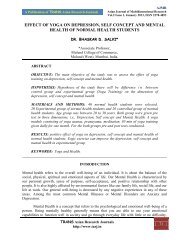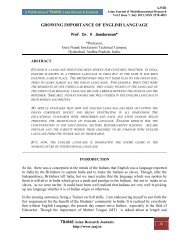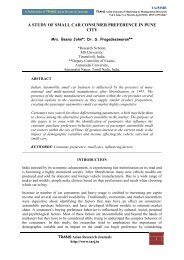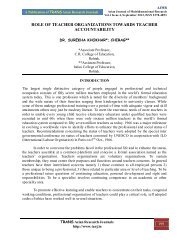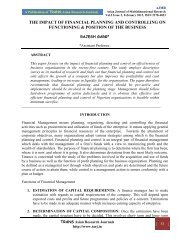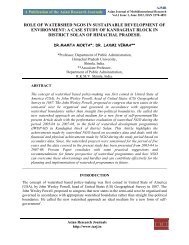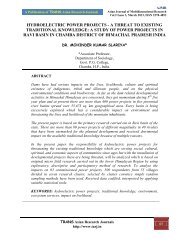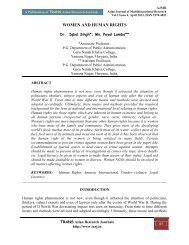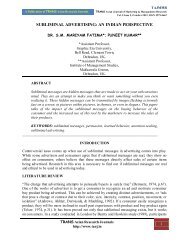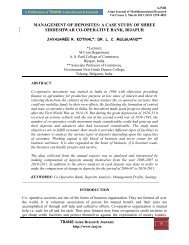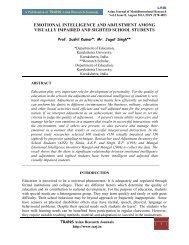4.5, Swadesh Kumar Dash.pdf - tarj.in
4.5, Swadesh Kumar Dash.pdf - tarj.in
4.5, Swadesh Kumar Dash.pdf - tarj.in
You also want an ePaper? Increase the reach of your titles
YUMPU automatically turns print PDFs into web optimized ePapers that Google loves.
A Publication of TRANS Asian Research Journals<br />
AJMR<br />
Asian Journal of Multidimensional Research<br />
Vol.2 Issue 4, April 2013, ISSN 2278-4853<br />
INSURANCE INDUSTRY IN INDIA - PROSPECTS AND CHALLENGES<br />
ABSTRACT<br />
<strong>Swadesh</strong> <strong>Kumar</strong> <strong>Dash</strong>*; Dr. Tushar Kanti Pany**<br />
*Ph. D Scholar,<br />
Bhubaneswar, India.<br />
**Assistant Professor,<br />
Ravenshaw University,<br />
Cuttack, India.<br />
Indian economy and <strong>in</strong>dustry has undergone significant transformation s<strong>in</strong>ce 1991-<br />
mov<strong>in</strong>g away from state controlled to a competitive market economy. The most<br />
remarkable of this transformation has been noted <strong>in</strong> the f<strong>in</strong>ancial sector,<br />
particularly, <strong>in</strong> the Indian Insurance Industry which has opened up to all<br />
competitors- <strong>in</strong>tegrat<strong>in</strong>g f<strong>in</strong>ancial services to the global economy. IRDA was<br />
established <strong>in</strong> 1999 to protect the <strong>in</strong>terest of policyholders for promot<strong>in</strong>g and<br />
ensur<strong>in</strong>g orderly growth of the <strong>in</strong>surance <strong>in</strong>dustry and for matters connected<br />
therewith and also to amend the Insurance Act 1938, LIC Act 1956 and G.I. Bus<strong>in</strong>ess<br />
Act 1972. Under IRDA Act, 1999, Indian Insurance company means, any <strong>in</strong>surer<br />
be<strong>in</strong>g a company which is formed and registered under the companies Act, 1956, <strong>in</strong><br />
which the aggregate hold<strong>in</strong>g of equity shares by a foreign company do not exceed<br />
26% paid up equity capital of such Indian Insurance company and whose sole<br />
purpose is to carry on life or general or re-<strong>in</strong>surance bus<strong>in</strong>ess. Enhancement of this<br />
26% to 49% is at higher level discussion stage. FDI cannot be viewed from the<br />
f<strong>in</strong>ancial perspective alone. It br<strong>in</strong>gs experience shar<strong>in</strong>g, technology up gradation,<br />
specialized skills, better operational efficiency, improved perceptions by re<strong>in</strong>surance<br />
companies, and faster evolution of <strong>in</strong>dustry. S<strong>in</strong>ce Indian Insurance market is<br />
gett<strong>in</strong>g <strong>in</strong>tegrated <strong>in</strong>to Global Insurance Industry, we must analyze and understand<br />
the prospects of Insurance bus<strong>in</strong>ess <strong>in</strong> India <strong>in</strong> the light of follow<strong>in</strong>g trends as<br />
described and <strong>in</strong> tabular forms.<br />
____________________________________________________________________________<br />
THE INDIAN ECONOMY<br />
INTRODUCTION<br />
1. Aga<strong>in</strong>st the backdrop of adverse macro-economic factors, the Indian economy measured <strong>in</strong><br />
terms of Gross Domestic Product (GDP) registered a growth rate of 6.5 per cent <strong>in</strong> 2011-12,<br />
which is the lowest annual growth rate of last decade. Further, this growth rate also happened to<br />
be lower than even that of year 2008-09, the year when the f<strong>in</strong>ancial crisis began. In that year,<br />
the Indian economy grew at 6.7 per cent. The harden<strong>in</strong>g of <strong>in</strong>terest rate, moderation <strong>in</strong> demand<br />
(both domestic and external), slowdown <strong>in</strong> consumption expenditure, especially <strong>in</strong> <strong>in</strong>terest rate<br />
sensitive commodities, subdued bus<strong>in</strong>ess confidence and global economic uncerta<strong>in</strong>ty<br />
TRANS Asian Research Journals<br />
http://www.<strong>tarj</strong>.<strong>in</strong><br />
46
A Publication of TRANS Asian Research Journals<br />
AJMR<br />
Asian Journal of Multidimensional Research<br />
Vol.2 Issue 4, April 2013, ISSN 2278-4853<br />
collectively contributed to the weaken<strong>in</strong>g of the Indian economy. While the slowdown <strong>in</strong> the<br />
economy rema<strong>in</strong>ed across the board, the <strong>in</strong>dustrial sector appeared to be the worst hit. The sector<br />
reported a meagre growth rate of 2.6 per cent dur<strong>in</strong>g 2011-12, as compared to 6.8 percent <strong>in</strong> the<br />
previous year. With this, the sector grew at an average growth rate of 6.3 per cent <strong>in</strong> the last five<br />
years (2007-08 to 2011-12). The slowdown <strong>in</strong> <strong>in</strong>dustrial production appeared to be almost across<br />
all sub-sectors.<br />
2. The agricultural sector too grew at a substantially lower rate of 2.8 per cent <strong>in</strong> 2011-12, as<br />
compared to 7.0 per cent achieved <strong>in</strong> the previous year.<br />
3. The services sector cont<strong>in</strong>ued to grow at a faster rate <strong>in</strong> 2011-12. It witnessed a growth of 8.5<br />
per cent (previous year 9.2 per cent). Amongst the various service sectors, the growth rate <strong>in</strong> the<br />
“f<strong>in</strong>anc<strong>in</strong>g, <strong>in</strong>surance, real estate and bus<strong>in</strong>ess” services stood at 9.6 per cent <strong>in</strong> 2011-12, as<br />
compared to 10.4 per cent of previous year. The average annual growth rate of this segment<br />
cont<strong>in</strong>ued to be <strong>in</strong> double digit (10.7 per cent) dur<strong>in</strong>g the period of past five years, viz. 2007-08<br />
to 2011-12. The share, <strong>in</strong> terms of real GDP, of the services sector <strong>in</strong> the Indian economy<br />
cont<strong>in</strong>ued to rise consistently. The share went up further to 66.8 per cent <strong>in</strong> 2011-12 (65.5 per<br />
cent <strong>in</strong> 2010-11), because of better performance of this sector <strong>in</strong> absolute as well as <strong>in</strong> relative (to<br />
agricultural and <strong>in</strong>dustrial sector) sense. With<strong>in</strong> the services sectors, the “f<strong>in</strong>anc<strong>in</strong>g, <strong>in</strong>surance,<br />
real estate and bus<strong>in</strong>ess” rema<strong>in</strong>s the largest component with 17.9 per cent share <strong>in</strong> the Indian<br />
economy. The same has <strong>in</strong>creased gradually over the last few years, viz. 2007-08 (16.1 per cent),<br />
2008-09 (16.9 per cent), 2009-10 (17.1 per cent) and 2010-11 (17.4 per cent).<br />
GLOBAL ECONOMIC ENVIRONMENT<br />
1. Accord<strong>in</strong>g to the latest World Economic Outlook (WEO) published by the International<br />
Monetary Fund (IMF), the world economy is projected to grow at the rate of 3.5 percent <strong>in</strong> the<br />
year 2012, which is lower when compared to the 5.3 per cent and 4.0 per cent growth achieved<br />
dur<strong>in</strong>g 2010 and 2011 respectively. The slowdown <strong>in</strong> the global economy, which started <strong>in</strong> the<br />
advanced economies, ma<strong>in</strong>ly of Europe, has spread to major emerg<strong>in</strong>g economies too <strong>in</strong>clud<strong>in</strong>g<br />
Ch<strong>in</strong>a, India and Brazil.<br />
2. As per projections of the IMF, the euro area would cont<strong>in</strong>ue to reel under recession <strong>in</strong> 2012 as<br />
a result of the sovereign debt crisis, problems <strong>in</strong> the bank<strong>in</strong>g sector and fi scal consolidation<br />
efforts of various governments. Due to recession <strong>in</strong> the European economy, the advanced<br />
economies as a group are expected to grow only at the rate of 1.5 per cent <strong>in</strong> 2012 and 2 per cent<br />
<strong>in</strong> 2013. Similarly, the real GDP growth <strong>in</strong> the emerg<strong>in</strong>g and develop<strong>in</strong>g economies is projected<br />
to slow down from 6.25 per cent <strong>in</strong> 2011 to 5.75 per cent <strong>in</strong> 2012.<br />
3. Many policy <strong>in</strong>itiatives are needed to ensure recovery of the global economy, says the IMF<br />
Report. In the short term, these <strong>in</strong>clude efforts to address the euro area crisis, a temperate<br />
approach to fiscal restra<strong>in</strong>t <strong>in</strong> response to weaker activity, cont<strong>in</strong>uation of accommodative<br />
monetary policies and ample liquidity to the f<strong>in</strong>ancial sector. In the long term, the most<br />
important policy <strong>in</strong>itiatives <strong>in</strong>clude fundamental reforms <strong>in</strong> the f<strong>in</strong>ancial sector, progress with<br />
fiscal consolidation <strong>in</strong>clud<strong>in</strong>g ambitious reform of entitlement programs, and structural reforms<br />
to boost potential output.<br />
TRANS Asian Research Journals<br />
http://www.<strong>tarj</strong>.<strong>in</strong><br />
47
A Publication of TRANS Asian Research Journals<br />
AJMR<br />
Asian Journal of Multidimensional Research<br />
Vol.2 Issue 4, April 2013, ISSN 2278-4853<br />
4. Many of the emerg<strong>in</strong>g & develop<strong>in</strong>g economies have had an unusually good run over the past<br />
decade, supported by rapid credit growth or high commodity prices. Though credit growth is a<br />
manifestation of f<strong>in</strong>ancial deepen<strong>in</strong>g, it cannot cont<strong>in</strong>ue to expand at its present pace without<br />
rais<strong>in</strong>g serious concerns about the quality of bank lend<strong>in</strong>g. Similarly, commodity prices cannot<br />
cont<strong>in</strong>ue to grow at the elevated pace other than exhibit<strong>in</strong>g short-term spikes related to<br />
geopolitical tensions. The key near-term challenge for emerg<strong>in</strong>g and develop<strong>in</strong>g economies is<br />
how to appropriately calibrate macroeconomic policies to address the significant downside risks<br />
from advanced economies while keep<strong>in</strong>g <strong>in</strong> check overheat<strong>in</strong>g pressures from strong activity,<br />
high credit growth, volatile capital flows, still elevated commodity prices, and renewed risks to<br />
<strong>in</strong>flation and fiscal positions from energy prices.<br />
WORLD INSURANCE MARKETS<br />
1. As per the World Insurance Report, published by the re<strong>in</strong>surance major “Swiss Re”, the global<br />
direct premium dur<strong>in</strong>g 2011 dropped by 0.8 per cent aga<strong>in</strong>st a surge at 2.7 per cent growth<br />
witnessed <strong>in</strong> the previous year. Globally, life <strong>in</strong>surance premium accounted for 57 per cent of<br />
total <strong>in</strong>surance premium. This share is higher <strong>in</strong> advanced economies than <strong>in</strong> the emerg<strong>in</strong>g<br />
markets. Dur<strong>in</strong>g 2011, global life <strong>in</strong>surance premium dropped by 2.7 per cent to USD 2627<br />
billion. The premium volume fell <strong>in</strong> Western Europe, Ch<strong>in</strong>a and India, whereas, it rose <strong>in</strong> Middle<br />
East and Lat<strong>in</strong> America.<br />
2. On the other hand, the premium <strong>in</strong> non-life <strong>in</strong>surance bus<strong>in</strong>ess grew by 1.9 per cent. Lat<strong>in</strong><br />
America reported remarkably high growth. The Report mentions that the year 2011 witnessed<br />
exceptionally high catastrophe losses <strong>in</strong> Japan, Australia, and the United States, while European<br />
countries generally enjoyed low catastrophe claims. In 2011, total economic losses to Society<br />
due to disasters (both <strong>in</strong>sured and un<strong>in</strong>sured) reached an estimated USD 370 billion, compared to<br />
USD 226 billion <strong>in</strong> 2010. The earthquake <strong>in</strong> Japan, the country’s worst on record <strong>in</strong> terms of<br />
magnitude, alone accounted for 57 percent of global economic losses. The <strong>in</strong>sured losses from<br />
natural catastrophes appeared to be to the tune of USD 110 billion.<br />
3. The analysis and growth experience of the <strong>in</strong>surance <strong>in</strong>dustry <strong>in</strong> most countries <strong>in</strong>dicate that<br />
the deepen<strong>in</strong>g and widen<strong>in</strong>g of the <strong>in</strong>surance services are positively correlated to the degree of<br />
competition and the number of firms <strong>in</strong> the market. In a closed and restricted market<br />
environment, the growth of <strong>in</strong>surance services slows down. The countries which have followed<br />
the open and liberalized policy have experienced quantum jump <strong>in</strong> the <strong>in</strong>surance services.<br />
4. Another trend is that the growth was by and large higher <strong>in</strong> those countries where relatively<br />
less controls were imposed on <strong>in</strong>surance <strong>in</strong>dustries. Regulations and Controls if persuaded and<br />
imposed beyond a po<strong>in</strong>t may prove to be <strong>in</strong>hibitive and counterproductive.<br />
INDIAN INSURANCE SECTOR<br />
1. After open<strong>in</strong>g up of Insurance sectors, the capital requirements for start<strong>in</strong>g a general or life<br />
<strong>in</strong>surance company is equity paid-up capital of Rs.100 crore and for start<strong>in</strong>g a re<strong>in</strong>surance<br />
company it is Rs.200 crore. The solvency marg<strong>in</strong> requirement shall be highest of the follow<strong>in</strong>g<br />
TRANS Asian Research Journals<br />
http://www.<strong>tarj</strong>.<strong>in</strong><br />
48
A Publication of TRANS Asian Research Journals<br />
AJMR<br />
Asian Journal of Multidimensional Research<br />
Vol.2 Issue 4, April 2013, ISSN 2278-4853<br />
(a) Rs.50 crore (Rs.100 crore for re<strong>in</strong>surer); or (b) a sum equivalent to 25% of the premium<br />
<strong>in</strong>come; or (c) a sum equivalent to 30% of net <strong>in</strong>curred claims.<br />
2. As at end-September 2012, there are fifty-two <strong>in</strong>surance companies operat<strong>in</strong>g <strong>in</strong> India; of<br />
which twenty four are <strong>in</strong> the life <strong>in</strong>surance bus<strong>in</strong>ess and twenty-seven are <strong>in</strong> non-life <strong>in</strong>surance<br />
bus<strong>in</strong>ess. In addition, General Insurance Corporation (GIC) is the sole national re<strong>in</strong>surer. The life<br />
<strong>in</strong>surance <strong>in</strong>dustry recorded a premium <strong>in</strong>come of `2, 87,072 crore dur<strong>in</strong>g 2011-12 as aga<strong>in</strong>st<br />
2,91,639 crore <strong>in</strong> the previous f<strong>in</strong>ancial year, register<strong>in</strong>g a negative growth of 1.57 per cent.<br />
While private sector <strong>in</strong>surers posted <strong>4.5</strong>2 per cent decl<strong>in</strong>e (11.08 per cent growth <strong>in</strong> previous<br />
year) <strong>in</strong> their premium <strong>in</strong>come, Life Insurance Corporation (LIC), the fully state owned<br />
<strong>in</strong>surance company, recorded 0.29 per cent decl<strong>in</strong>e (9.35 per cent growth <strong>in</strong> previous year), <strong>in</strong> its<br />
total premium underwritten. While the renewal premium accounted for 60.31 per cent (56.66 per<br />
cent <strong>in</strong> 2010-11) of the total premium received by the life <strong>in</strong>surers, first year premium<br />
contributed the rema<strong>in</strong><strong>in</strong>g 39.69 per cent (43.34 per cent <strong>in</strong> 2010-11). Dur<strong>in</strong>g 2011-12, the<br />
growth <strong>in</strong> renewal premium was 4.77 per cent (6.23 per cent <strong>in</strong> 2010-11). First year premium<br />
registered a decl<strong>in</strong>e of 9.85 per cent <strong>in</strong> comparison to growth of 15.02 per cent dur<strong>in</strong>g 2010-11.<br />
3. In the non-life segment, the <strong>in</strong>surers underwrote gross direct premium of `52,876 crore <strong>in</strong><br />
India for the year 2011-12 as aga<strong>in</strong>st `42,576 crore <strong>in</strong> 2010-11, register<strong>in</strong>g a growth of 24.19 per<br />
cent as aga<strong>in</strong>st an <strong>in</strong>crease of 22.98 per cent recorded <strong>in</strong> the previous year. The public sector<br />
<strong>in</strong>surers exhibited growth <strong>in</strong> 2011-12 at 21.50 per cent; as aga<strong>in</strong>st the previous year’s growth rate<br />
of 21.84 percent. The private sector general <strong>in</strong>surers registered a growth of 28.06 per cent, which<br />
is higher than 24.67 percent achieved dur<strong>in</strong>g the previous year.<br />
PENETRATION AND DENSITY<br />
1. The potential and performance of the <strong>in</strong>surance sector is universally assessed with reference to<br />
two parameters, viz., <strong>in</strong>surance penetration and <strong>in</strong>surance density. These two are often used to<br />
determ<strong>in</strong>e the level of development of the <strong>in</strong>surance sector <strong>in</strong> a country. Insurance penetration is<br />
def<strong>in</strong>ed as the ratio of premium underwritten <strong>in</strong> a given year to the Gross Domestic Product<br />
(GDP). The <strong>in</strong>surance penetration <strong>in</strong> India, which surged consistently till 2009-10, has slipped<br />
s<strong>in</strong>ce 2010-11 on account of slowdown <strong>in</strong> life <strong>in</strong>surance premium as compared to the growth rate<br />
of the Indian economy. Life <strong>in</strong>surance penetration had consistently gone up from 2.15 per cent <strong>in</strong><br />
2001 to 4.60 <strong>in</strong> 2009, before slipp<strong>in</strong>g to 4.40 per cent <strong>in</strong> 2010 and further slipp<strong>in</strong>g to 3.40 per<br />
cent <strong>in</strong> 2011.<br />
2. However, penetration of the non-life <strong>in</strong>surance sector <strong>in</strong> the country has rema<strong>in</strong>ed near<br />
constant <strong>in</strong> the range of 0.55-0.75 per cent over the last 10 years (0.71 per cent <strong>in</strong> 2010 and 0.70<br />
<strong>in</strong> 2011).<br />
3. Insurance density is def<strong>in</strong>ed as the ratio of premium underwritten <strong>in</strong> a given year to the total<br />
population (measured <strong>in</strong> USD for convenience of comparison)( Per capita premium). India has<br />
reported consistent <strong>in</strong>crease <strong>in</strong> <strong>in</strong>surance density every year s<strong>in</strong>ce the sector was opened up for<br />
private competition <strong>in</strong> the year 2000. However, for the first time <strong>in</strong> 2011, there was a fall <strong>in</strong><br />
<strong>in</strong>surance density. The life <strong>in</strong>surance density <strong>in</strong> India has gone up from USD 9.1 <strong>in</strong> 2001 to USD<br />
TRANS Asian Research Journals<br />
http://www.<strong>tarj</strong>.<strong>in</strong><br />
49
A Publication of TRANS Asian Research Journals<br />
AJMR<br />
Asian Journal of Multidimensional Research<br />
Vol.2 Issue 4, April 2013, ISSN 2278-4853<br />
49.0 <strong>in</strong> 2011 though it reached the peak of USD 55.7 <strong>in</strong> 2010. The Insurance density of non-life<br />
sector reached the peak of USD 10.0 <strong>in</strong> 2011 from its level of USD 2.4 <strong>in</strong> 2001.<br />
MICRO INSURANCE<br />
1. The IRDA regulations impose obligations on <strong>in</strong>surers towards the rural population - to sell a<br />
specified percentage of policies and underwrite specified percentage of gross premium<br />
underwritten for life and non-life <strong>in</strong>surance companies respectively; and cover a specifi ed<br />
number of lives/assets belong<strong>in</strong>g to people below poverty l<strong>in</strong>e or those pursu<strong>in</strong>g certa<strong>in</strong><br />
traditional occupations.<br />
2. In the life <strong>in</strong>surance bus<strong>in</strong>ess of the micro <strong>in</strong>surance, the Individual New Bus<strong>in</strong>ess premium <strong>in</strong><br />
the year stood at `115.68 crore for 46.20 lakh new policies, the group bus<strong>in</strong>ess premium<br />
amounted to `109.82 crore cover<strong>in</strong>g 1.02 crore of lives. LIC contributed most of the bus<strong>in</strong>ess<br />
procured <strong>in</strong> this portfolio by garner<strong>in</strong>g `106.03 crore of <strong>in</strong>dividual premium from 38.26 lakh<br />
lives and `98.32 crore of group premium underwrit<strong>in</strong>g 94.44 lakh lives.<br />
REVISION IN MOTOR THIRD PARTY PREMIUM RATES<br />
Till the end of year 2006, the general <strong>in</strong>surance bus<strong>in</strong>ess <strong>in</strong> India was tariff-based which was<br />
be<strong>in</strong>g adm<strong>in</strong>istered by the erstwhile Tariff Advisory Committee (TAC). The TAC vide its<br />
circular no TAC/7/06 dated 4 th December 2006 decided and the rates, terms, conditions &<br />
regulations applicable to fire, eng<strong>in</strong>eer<strong>in</strong>g, motor, workmen’s compensation and other classes of<br />
bus<strong>in</strong>ess which were under tariffs were withdrawn from 1st January 2007. The motor TP<br />
premium rates which were set effective from 1st January, 2007 were not revised by the Authority<br />
till the end of year 2010-11. Due to the huge operat<strong>in</strong>g losses <strong>in</strong> this segment , the Authority<br />
notified the revised premium rates for motor third party <strong>in</strong>surance cover with effect from 25th<br />
April, 2011 only to the tune of 10 per cent <strong>in</strong> respect of two wheelers and private cars; and 68.5<br />
per cent <strong>in</strong> respect of the commercial vehicles.<br />
REINSURANCE<br />
The proposed amendments to the regulations <strong>in</strong>clude <strong>in</strong>corporat<strong>in</strong>g additional def<strong>in</strong>itions /<br />
modify<strong>in</strong>g exist<strong>in</strong>g def<strong>in</strong>itions, retentions be<strong>in</strong>g l<strong>in</strong>ked to quality of risk, expand<strong>in</strong>g the scope of<br />
re<strong>in</strong>surance programs to <strong>in</strong>clude Alternative Risk transfer (ART) techniques, pools etc.,<br />
prescrib<strong>in</strong>g additional disclosures, prescrib<strong>in</strong>g changes to the retention levels of 1999-2000, and<br />
prescrib<strong>in</strong>g additional returns, to be filed with the Authority, fil<strong>in</strong>g of <strong>in</strong>surer’s re<strong>in</strong>surance treaty<br />
duly approved by the Board, amongst others.<br />
HEALTH INSURANCE<br />
Health Insurance cont<strong>in</strong>ues to be one of the most rapidly grow<strong>in</strong>g sectors <strong>in</strong> the Indian <strong>in</strong>surance<br />
<strong>in</strong>dustry. The growth of health <strong>in</strong>surance <strong>in</strong>dustry lies ma<strong>in</strong>ly <strong>in</strong> better customer orientation <strong>in</strong><br />
terms of servic<strong>in</strong>g the customers, standardization of procedures and def<strong>in</strong>itions across the<br />
<strong>in</strong>dustry. Standardization provides simple yet <strong>in</strong>novative products, better understand<strong>in</strong>g of the<br />
terms by the public, less compla<strong>in</strong>ts and easy penetration <strong>in</strong> the market. IRDA has also taken up<br />
TRANS Asian Research Journals<br />
http://www.<strong>tarj</strong>.<strong>in</strong><br />
50
A Publication of TRANS Asian Research Journals<br />
AJMR<br />
Asian Journal of Multidimensional Research<br />
Vol.2 Issue 4, April 2013, ISSN 2278-4853<br />
key <strong>in</strong>itiatives <strong>in</strong>clud<strong>in</strong>g constitution of the Health Insurance Forum, standardiz<strong>in</strong>g of claims<br />
formats and other documents. With the objective to track the bus<strong>in</strong>ess progress of health<br />
<strong>in</strong>surance <strong>in</strong>dustry as also to regulate the health <strong>in</strong>surance <strong>in</strong>dustry <strong>in</strong> India, IRDA has<br />
formulated IRDA (Health Insurance) Regulations, 2012, which are presently <strong>in</strong> the advanced<br />
stage of discussions for notification.<br />
AMALGAMATION OF INSURANCE COMPANIES<br />
The Insurance Act, 1938 lays down the framework for amalgamation of life <strong>in</strong>surance<br />
companies, but no such provision for non-life <strong>in</strong>surance companies, this anomaly is proposed to<br />
be rectified <strong>in</strong> the Insurance Amendment Bill, 2008, to address the statutory/regulatory gap with<br />
respect to the non-life <strong>in</strong>surance companies. Pend<strong>in</strong>g the amendment, the Authority has laid<br />
down the framework for amalgamation of non-life <strong>in</strong>surance companies through notification of<br />
the necessary regulations <strong>in</strong> this regard. While lay<strong>in</strong>g down the regulatory framework, the<br />
Authority has been guided by the need for protection of the policyholders’ <strong>in</strong>terests.<br />
SOLVENCY MARGIN<br />
Solvency marg<strong>in</strong> is an <strong>in</strong>dex to measure the f<strong>in</strong>ancial soundness of an <strong>in</strong>surer to meet the<br />
contracted liabilities <strong>in</strong> his books with the resources available to him. Authorities were disturbed<br />
by such catastrophes that cause immense damage to the f<strong>in</strong>ancial <strong>in</strong>terests of the policy holders<br />
who put their sav<strong>in</strong>gs at the disposal of <strong>in</strong>surance companies through various forms of <strong>in</strong>surance<br />
contracts. Actuaries developed the concept of solvency and regulators impose on <strong>in</strong>surers the<br />
need for compulsory prudence of bus<strong>in</strong>ess practice to ensure public confidence. The details of<br />
the regulator prescribed solvency <strong>in</strong>dex varied from country to country but the central idea was<br />
to ensure that the <strong>in</strong>surer do not over-promise the policy holders but at the same time live up to<br />
their reasonable expectation of a return on their sav<strong>in</strong>gs through <strong>in</strong>surance. IRDA regulation<br />
INDIAN INSURANCE IN THE GLOBAL SCENARIO<br />
1. In the life <strong>in</strong>surance bus<strong>in</strong>ess, India ranked 10 th among the 156 countries, for which the data is<br />
published by Swiss Re. Dur<strong>in</strong>g 2011-12, the life <strong>in</strong>surance premium <strong>in</strong> India decl<strong>in</strong>ed by 8.5 per<br />
cent (<strong>in</strong>flation adjusted). Dur<strong>in</strong>g the same period, the global life <strong>in</strong>surance premium decl<strong>in</strong>ed by<br />
2.7 per cent. The share of Indian life <strong>in</strong>surance sector <strong>in</strong> global life <strong>in</strong>surance market stood at<br />
2.30 per cent dur<strong>in</strong>g 2011, as aga<strong>in</strong>st 2.54 per cent <strong>in</strong> 2010.<br />
2. The non-life <strong>in</strong>surance sector witnessed a significant growth of 13.5 per cent dur<strong>in</strong>g 2011-12.<br />
Its performance is far better when compared to global non-life premium, which expanded by a<br />
meager 1.8 per cent dur<strong>in</strong>g the same period. The share of Indian non-life <strong>in</strong>surance premium <strong>in</strong><br />
global non-life <strong>in</strong>surance premium <strong>in</strong>creased slightly from 0.57 per cent <strong>in</strong> 2010-11 to 0.62 per<br />
cent <strong>in</strong> the year 2011-12. India stood at 19th rank <strong>in</strong> global non-life premium <strong>in</strong>come.<br />
TRANS Asian Research Journals<br />
http://www.<strong>tarj</strong>.<strong>in</strong><br />
51
A Publication of TRANS Asian Research Journals<br />
AJMR<br />
Asian Journal of Multidimensional Research<br />
Vol.2 Issue 4, April 2013, ISSN 2278-4853<br />
TABLE.1<br />
TABLE- 2<br />
TRANS Asian Research Journals<br />
http://www.<strong>tarj</strong>.<strong>in</strong><br />
52
A Publication of TRANS Asian Research Journals<br />
AJMR<br />
Asian Journal of Multidimensional Research<br />
Vol.2 Issue 4, April 2013, ISSN 2278-4853<br />
TABLE 3 – INSURANCE DENSITY IN SELECT COUNTRIES-2011<br />
TABLE.4 – INSURANCE PENETRATION IN SELECT COUNTRIES-2011<br />
TRANS Asian Research Journals<br />
http://www.<strong>tarj</strong>.<strong>in</strong><br />
53
A Publication of TRANS Asian Research Journals<br />
AJMR<br />
Asian Journal of Multidimensional Research<br />
Vol.2 Issue 4, April 2013, ISSN 2278-4853<br />
TABLE.5 - INSURANCE PENETRATION AND DENSITY IN INDIA<br />
TABLE.6 – INSURANCE DENSITY IN INDIA<br />
TRANS Asian Research Journals<br />
http://www.<strong>tarj</strong>.<strong>in</strong><br />
54
A Publication of TRANS Asian Research Journals<br />
AJMR<br />
Asian Journal of Multidimensional Research<br />
Vol.2 Issue 4, April 2013, ISSN 2278-4853<br />
TABLE 7 – INSURANCE PENETRATION IN INDIA<br />
RELATIONSHIP BETWEEN INSURANCE PENETRATION AND PER CAPITA GDP<br />
The ratio of <strong>in</strong>surance density to the <strong>in</strong>surance penetration is simply the per capita GDP, an<br />
<strong>in</strong>dicator of per person economic activity of the economy. The per capita GDP is often regarded<br />
as a good proxy for the standard of liv<strong>in</strong>g of the people <strong>in</strong> the economy and is often used to<br />
compare the relative standard of liv<strong>in</strong>g between the economies.<br />
There are several studies [Carter and Dick<strong>in</strong>son (1992), Enz (2000), Kamiya (2012), Sastry<br />
(2011), S<strong>in</strong>ha et al (2012), Zheng et al (2008), etc.], which have attempted to exam<strong>in</strong>e the nature<br />
of <strong>in</strong>ter-relationship between the <strong>in</strong>surance penetration and the per capita GDP. These studies<br />
have revealed that a positive relationship holds between <strong>in</strong>surance penetration and per capita<br />
GDP. Insurance penetration normally <strong>in</strong>creases with the <strong>in</strong>crease <strong>in</strong> the per capita GDP. The<br />
relationship between the two could be l<strong>in</strong>ear or non-l<strong>in</strong>ear (curvil<strong>in</strong>ear). A simple l<strong>in</strong>ear<br />
relationship will mean that the <strong>in</strong>come elasticity of demand for <strong>in</strong>surance is a constant. In case,<br />
the relation is curvil<strong>in</strong>ear, the elasticity would no more be a constant and would change with the<br />
level of per capita GDP and would be dictated by the mathematical form of the non-l<strong>in</strong>earity<br />
(such as, exponential, logistic etc.). The studies of Carter and Dick<strong>in</strong>son (1992) and Enz (2000)<br />
<strong>in</strong>dicated that the relationship between the <strong>in</strong>surance penetration and per capita GDP can be<br />
expla<strong>in</strong>ed with an S-curve (a non-l<strong>in</strong>ear form). They demonstrated that the <strong>in</strong>surance penetration<br />
cannot go on <strong>in</strong>creas<strong>in</strong>g with the same pace forever with <strong>in</strong>come per capita. The study of Enz<br />
(2000) proposed a logistic curve, which tracks an S-curve appropriately. Enz (2000) analyzed the<br />
<strong>in</strong>surance penetration by plott<strong>in</strong>g it with the per capita GDP for select countries both for the life<br />
and non-life segments, separately. It revealed that there exists a level of per capita GDP at which<br />
the <strong>in</strong>come elasticity of demand for <strong>in</strong>surance reaches to the maximum level for both segments<br />
TRANS Asian Research Journals<br />
http://www.<strong>tarj</strong>.<strong>in</strong><br />
55
A Publication of TRANS Asian Research Journals<br />
AJMR<br />
Asian Journal of Multidimensional Research<br />
Vol.2 Issue 4, April 2013, ISSN 2278-4853<br />
(life and non-life) of <strong>in</strong>surance. Subsequent to this po<strong>in</strong>t of maxima, the <strong>in</strong>surance penetration<br />
starts decelerat<strong>in</strong>g (<strong>in</strong>creas<strong>in</strong>g at a slower rate) with the <strong>in</strong>crease of per capita GDP. The study<br />
also attempted to identify the countries, which are consistently above or below the S-curve, and<br />
<strong>in</strong>dicated that these deviations are on account of other factors (for example, socio-demographic<br />
and cultural characteristics), which are largely country-specific, which affect the <strong>in</strong>surance<br />
bus<strong>in</strong>ess of these specific counties.<br />
INDIAN SCENARIO (IN DIFFERENT STATES)<br />
1.The scatter plot of S-curve <strong>in</strong> the study of Enz (2000) reveals that <strong>in</strong>surance penetration <strong>in</strong><br />
India lies well above the po<strong>in</strong>t of the estimated S-curve. Accord<strong>in</strong>gly, given the assumptions of<br />
model <strong>in</strong> Enz (2000), it is <strong>in</strong>dicated that the <strong>in</strong>surance penetration <strong>in</strong> India is higher than what the<br />
S-curve suggests. It is <strong>in</strong>terest<strong>in</strong>g to note that there exist other prom<strong>in</strong>ent factors (other than the<br />
per capita GDP), which <strong>in</strong>fluence the growth of Indian <strong>in</strong>surance bus<strong>in</strong>ess positively. These<br />
factors could be demand driven (such as, socio-demographic characteristics of<br />
prospect/policyholders, risk appetite, etc.) or, supply driven (such as, quality of distribution<br />
channel, product <strong>in</strong>novation, etc.) or comb<strong>in</strong>ation of both. While the presence of other factors<br />
(other than per capita GDP) is evident <strong>in</strong> case of India, it is expected that these would vary across<br />
various states and union territories of India. Treat<strong>in</strong>g these states and union territories as<br />
<strong>in</strong>dependent economies, the <strong>in</strong>surance penetration as well as <strong>in</strong>surance density of <strong>in</strong>dividual<br />
states and union territories can be computed us<strong>in</strong>g their respective Premium underwritten, GDP<br />
and Population.<br />
2. DATA DESCRIPTIONS AND LIMITATIONS<br />
The state-wise computed data of <strong>in</strong>surance penetration and <strong>in</strong>surance density is provided. It has<br />
been computed annually for the period 2006-07 to 2011-12. The premium figures perta<strong>in</strong> only to<br />
the <strong>in</strong>dividual new bus<strong>in</strong>ess first year premium of life <strong>in</strong>surance.<br />
The <strong>in</strong>surance penetration stands at 0.78 per cent <strong>in</strong> 2011-12, while the <strong>in</strong>surance penetration of<br />
total life <strong>in</strong>surance is 3.47 per cent. The <strong>in</strong>surance penetration of total life <strong>in</strong>surance penetration<br />
is 3.40 per cent <strong>in</strong> 2011-12 as per the Swiss Re estimates.<br />
The state-wise data on Gross Domestic Product and per capita Net Domestic Product have been<br />
taken from the Central Statistical Organization (CSO). While CSO publishes both the Gross<br />
Domestic Product (GDP) and Net Domestic Product (NDP) for various states/UTs, it publishes<br />
only Per Capita Net Domestic Product and not the Per Capita Gross Domestic Product. In<br />
accordance with the def<strong>in</strong>ition of the <strong>in</strong>surance penetration, the GDP is used for the computation<br />
of <strong>in</strong>surance penetration of various states and union territories. Further, it is taken at the current<br />
prices <strong>in</strong> order to be compatible with the premium figures.<br />
For the scatter plot between <strong>in</strong>surance penetration and the per capita GDP, the per capita NDP (at<br />
current prices) is used, as the per capita GDP is not available. Although, the per capita GDP can<br />
be computed by the formula [per capita GDP = (per capita NDP) * (GDP) / NDP] for various<br />
states / UTs, the same is not applied and rather the per capita NDP, as available directly, is used<br />
as a proxy for the per capita GDP. It may be mentioned that the per capita NDP for majority of<br />
TRANS Asian Research Journals<br />
http://www.<strong>tarj</strong>.<strong>in</strong><br />
56
A Publication of TRANS Asian Research Journals<br />
AJMR<br />
Asian Journal of Multidimensional Research<br />
Vol.2 Issue 4, April 2013, ISSN 2278-4853<br />
states (<strong>in</strong>clud<strong>in</strong>g All India figure) lies between the range of 85 to 90 per cent of the per capita<br />
GDP consistently. Accord<strong>in</strong>gly, by tak<strong>in</strong>g the per capita NDP for the scatter plot, the purpose of<br />
exam<strong>in</strong><strong>in</strong>g the nature of relationship between the <strong>in</strong>surance penetration and per capita GDP is<br />
well served.<br />
The state-wise data on population is available through Census 2001 and Census 2011. These are<br />
used to estimate the state wise population data for various years (2006-07 to 2011-12) us<strong>in</strong>g the<br />
Compound Average Growth Rate (CAGR) of the respective states and union territories with<br />
application of simple <strong>in</strong>terpolations.<br />
3.India is a large country with 35 states/UTs with vary<strong>in</strong>g levels of per capita GDP, <strong>in</strong>surance<br />
penetration and <strong>in</strong>surance density. The per capita NDP of India stood at 60,972 <strong>in</strong> 2011-12. The<br />
same, however, varied significantly across the states and UTs rang<strong>in</strong>g from a low of `24,681 (for<br />
Bihar) to a high of 1,92,652 (for Goa) and 1,75,812 (for Delhi). In the present context, 3 UTs viz.<br />
Dadra & Nagra Haveli, Daman & Diu and Lakshadweep have not been considered because of<br />
their meagre figures.<br />
4. SCATTER PLOT<br />
The scatter plot of <strong>in</strong>surance penetration versus the per capita NDP of all the states and union<br />
territories for available years (viz. 2006-07 to 2011-12) is given <strong>in</strong> the Chart. From the scatter<br />
diagram, it is clearly seen that there exists a positive relationship between <strong>in</strong>surance penetration<br />
and per capita NDP (as a proxy for per capita GDP) <strong>in</strong> the Indian context as well, <strong>in</strong> l<strong>in</strong>e with<br />
other studies. However, from the chart it is observed that many of the po<strong>in</strong>ts deviate significantly<br />
and are likely to depart from the straight l<strong>in</strong>e (if a l<strong>in</strong>ear relationship is established). Thus, the<br />
chart reveals that there is a presence of other factors also, which appear to be <strong>in</strong>fluenc<strong>in</strong>g<br />
<strong>in</strong>surance penetration at least for some of the states / union territories.<br />
5. ANALYSIS<br />
The study of S<strong>in</strong>ha et al (2012) identified the per capita number of agents and the per capita<br />
number of <strong>in</strong>surance offices (both are supply driven), as two other <strong>in</strong>fluenc<strong>in</strong>g factors, apart from<br />
per capita GDP, which expla<strong>in</strong>ed together large section of data. The above study also carried out<br />
a multiple l<strong>in</strong>ear regression analysis to (i) identify statistically significant factors <strong>in</strong>fluenc<strong>in</strong>g the<br />
<strong>in</strong>surance penetration and density, (ii) to identify the outlier states/UTs, which are deviat<strong>in</strong>g from<br />
the estimated straight l<strong>in</strong>e statistically significantly and, (iii) to classify the states/UTs, which<br />
have under-<strong>in</strong>surance, over <strong>in</strong>surance and adequate <strong>in</strong>surance given the assumptions of the<br />
model.<br />
In case of life <strong>in</strong>surance, given the high importance of per capita number of agents <strong>in</strong> the<br />
country, it is imperative to identify the states and UTs, which are at the extreme ends of under<strong>in</strong>surance<br />
and over-<strong>in</strong>surance. That is, there are few states, which have a low premium figure,<br />
despite the fact that relatively higher agents have been deployed by the various <strong>in</strong>surance<br />
companies there<strong>in</strong>. In contrast, few states are capable of underwrit<strong>in</strong>g good <strong>in</strong>surance bus<strong>in</strong>ess<br />
despite relatively low agents deployed there<strong>in</strong>. This poses questions on the allocation of<br />
<strong>in</strong>surance agents by the <strong>in</strong>surers <strong>in</strong> various parts of the country.<br />
TRANS Asian Research Journals<br />
http://www.<strong>tarj</strong>.<strong>in</strong><br />
57
A Publication of TRANS Asian Research Journals<br />
AJMR<br />
Asian Journal of Multidimensional Research<br />
Vol.2 Issue 4, April 2013, ISSN 2278-4853<br />
There could be possibility of <strong>in</strong>appropriate (<strong>in</strong>adequate or more than adequate) deployment of<br />
agents <strong>in</strong> particular region(s). Thus, the <strong>in</strong>surers need to analyze the mis-allocation, if any, <strong>in</strong> the<br />
distribution of agents, offices etc. and optimize it, subject to constra<strong>in</strong>ts. This may facilitate <strong>in</strong><br />
<strong>in</strong>creas<strong>in</strong>g the bus<strong>in</strong>ess volumes, and thus, push<strong>in</strong>g up both <strong>in</strong>surance penetration and <strong>in</strong>surance<br />
density of the country.<br />
TABLE.8<br />
6. The <strong>in</strong>surance density of life <strong>in</strong>surance sector had gone up from USD 9.1 <strong>in</strong> 2001 to USD 49.0<br />
<strong>in</strong> 2011 while reach<strong>in</strong>g the peak at USD 55.7 <strong>in</strong> 2010. Similarly, life <strong>in</strong>surance penetration<br />
surged from 2.15 per cent <strong>in</strong> 2001 to 4.60 per cent <strong>in</strong> 2009, before slipp<strong>in</strong>g to 4.40 per cent <strong>in</strong><br />
2010 and further slipp<strong>in</strong>g to 3.40 per cent <strong>in</strong> 2011.<br />
7. Over the last 10 years, the penetration of nonlife <strong>in</strong>surance sector <strong>in</strong> the country rema<strong>in</strong>ed<br />
steady with<strong>in</strong> the narrow range of 0.56-0.71 per cent. However, its density has gone up from<br />
USD 2.4 <strong>in</strong> 2001 to USD 10.0 <strong>in</strong> 2011.<br />
TRANS Asian Research Journals<br />
http://www.<strong>tarj</strong>.<strong>in</strong><br />
58
A Publication of TRANS Asian Research Journals<br />
AJMR<br />
Asian Journal of Multidimensional Research<br />
Vol.2 Issue 4, April 2013, ISSN 2278-4853<br />
APPRAISAL OF INDIAN INSURANCE MARKET<br />
MARKET SHARE OF LIFE INSURERS<br />
TABLE.9<br />
TRANS Asian Research Journals<br />
http://www.<strong>tarj</strong>.<strong>in</strong><br />
59
A Publication of TRANS Asian Research Journals<br />
AJMR<br />
Asian Journal of Multidimensional Research<br />
Vol.2 Issue 4, April 2013, ISSN 2278-4853<br />
TABLE.10<br />
TABLE.11<br />
TRANS Asian Research Journals<br />
http://www.<strong>tarj</strong>.<strong>in</strong><br />
60
A Publication of TRANS Asian Research Journals<br />
AJMR<br />
Asian Journal of Multidimensional Research<br />
Vol.2 Issue 4, April 2013, ISSN 2278-4853<br />
TABLE.12<br />
TABLE.13<br />
TRANS Asian Research Journals<br />
http://www.<strong>tarj</strong>.<strong>in</strong><br />
61
A Publication of TRANS Asian Research Journals<br />
AJMR<br />
Asian Journal of Multidimensional Research<br />
Vol.2 Issue 4, April 2013, ISSN 2278-4853<br />
TABLE.14<br />
CONCLUSIONS<br />
1. In India, limit of 26% <strong>in</strong> foreign <strong>in</strong>surance sharehold<strong>in</strong>g has not arrested development of jo<strong>in</strong>t<br />
ventures with <strong>in</strong>surers of good reputation <strong>in</strong> global market. Global f<strong>in</strong>ancial scenario is highly<br />
volatile with all socio economic models rang<strong>in</strong>g from Corporate Capitalist Democracy of USA to<br />
Liberalized Communist model of Ch<strong>in</strong>a. In this scenario, we should protect our newly<br />
restructured <strong>in</strong>surance market from aggressive assaults from f<strong>in</strong>ancially powerful groups.<br />
2. Investment regulations for <strong>in</strong>surers are liberalized to a reasonable extent keep<strong>in</strong>g adequate<br />
controls on the exposure of <strong>in</strong>surer’s fund to the unapproved <strong>in</strong>vestment <strong>in</strong> general stock market.<br />
But politically oriented <strong>in</strong>vestment, if they are tak<strong>in</strong>g place under pressure may cause problems<br />
for PSUs.<br />
3. In the Insurance bus<strong>in</strong>ess, the new players are handicapped due to lack of data. The premium<br />
depends on the data of risk frequency of car accidents, burglary, fire or death. The new <strong>in</strong>surers<br />
are sell<strong>in</strong>g fresh policies that promise to challenge some of the basic paradigms of the state<br />
owned <strong>in</strong>surance monopoly. There is a tendency to target the bus<strong>in</strong>ess of exist<strong>in</strong>g companies<br />
rather than expand<strong>in</strong>g the market by offer<strong>in</strong>g better service or other advantages.<br />
4. New <strong>in</strong>surers can profitably focus on the retail segment, especially <strong>in</strong> general <strong>in</strong>surance. At<br />
present personal <strong>in</strong>surance <strong>in</strong>clud<strong>in</strong>g health, householders, shopkeepers, accident and<br />
professional <strong>in</strong>demnity coverage constitute 15% of Indian General Insurance premium. New<br />
entrants can enhance this figure.<br />
TRANS Asian Research Journals<br />
http://www.<strong>tarj</strong>.<strong>in</strong><br />
62
A Publication of TRANS Asian Research Journals<br />
AJMR<br />
Asian Journal of Multidimensional Research<br />
Vol.2 Issue 4, April 2013, ISSN 2278-4853<br />
5. Life Insurance potential can be exam<strong>in</strong>ed by Insurers <strong>in</strong> details from three angles i.e. <strong>in</strong> terms<br />
of <strong>in</strong>surable population, sav<strong>in</strong>gs and consumption expenditure. In India, less than 30% of total<br />
<strong>in</strong>surable populations have been <strong>in</strong>sured. Jo<strong>in</strong>t efforts need to be made by all <strong>in</strong>surers to extend<br />
the coverage. Besides a wide range of product, there is need to focus on S<strong>in</strong>gle Premium,<br />
Retirement and pension plan, Health <strong>in</strong>surance, Children’s plan. 46% of total household sav<strong>in</strong>gs<br />
are <strong>in</strong> guaranteed return plan like NSC, PPF etc. There is need to convert to LI plans with regard<br />
to protection element, long term capital appreciation and dual tax benefits at <strong>in</strong>vestment and<br />
maturity. Less than 50% of total policies sold are <strong>in</strong> conventional plans; product mix is a good<br />
challenge.<br />
6. Provid<strong>in</strong>g <strong>in</strong>surance cover to lower strata of society through various schemes, micro <strong>in</strong>surance<br />
need urgent attention.<br />
7. E-Commerce and market conducts are two important areas which will strengthen the<br />
relationship between companies, consumers and regulators.<br />
8. In most of the countries, Insurance <strong>in</strong>dustries have not been allowed to operate <strong>in</strong> a free and<br />
competitive environment and are saddled with avoidable restrictions. The market forces should<br />
be allowed to operate and determ<strong>in</strong>e as to which are the best products and optimum price <strong>in</strong> the<br />
<strong>in</strong>terest of the consumers. Similarly most of the decisions relat<strong>in</strong>g to <strong>in</strong>vestment of funds,<br />
market<strong>in</strong>g of products, placement of re<strong>in</strong>surance bus<strong>in</strong>ess should be left to market<strong>in</strong>g forces. The<br />
objective beh<strong>in</strong>d regulations is to ensure f<strong>in</strong>ancial strength of the companies so that the <strong>in</strong>terest<br />
of the policy holders are protected, the objective could efficiently be achieved through macro<br />
level policies and management. These companies may also be encouraged to observe self<br />
discipl<strong>in</strong>e and code of conduct. For <strong>in</strong>stance, strict compliance to ma<strong>in</strong>ta<strong>in</strong> solvency marg<strong>in</strong> will<br />
itself ensure healthy f<strong>in</strong>ancial strength. The method of disclosure norms may be extensively<br />
used and enforced. The objective of protect<strong>in</strong>g the <strong>in</strong>terest of the consumers may well be<br />
achieved through these macro management policies without any need to resort to regulate micro<br />
level activities of the companies.<br />
9. There is no doubt at all that the Govt. monopoly over the <strong>in</strong>surance bus<strong>in</strong>ess had to end. There<br />
is cry<strong>in</strong>g need for better service more <strong>in</strong>novation and a comprehensive <strong>in</strong>surance cover. The<br />
obvious changes <strong>in</strong> the <strong>in</strong>surance markets are there for all to see new brands, new products, fresh<br />
advertis<strong>in</strong>g, and smart agents- all add<strong>in</strong>g up to the excitement. Innovation of products, services,<br />
speed and adoption of technology and professionalism and above all operation cost<br />
(management+procuration cost) will decide the future fate of <strong>in</strong>surance <strong>in</strong>dustry.<br />
REFERENCES<br />
Carter, R L and Dick<strong>in</strong>son, G M (1992): Obstacles to the liberalization of trade <strong>in</strong> <strong>in</strong>surance,<br />
Thames Essay No.58, Hemel<br />
Hempstead: Harverster Wheatsheaf, See Appendix IV, 175-188.<br />
Enz, R (2000): The S-curve relation between per-capita <strong>in</strong>come and <strong>in</strong>surance penetration,<br />
Geneva Papers on Risk and Insurance, 25 (3): 396-406.<br />
TRANS Asian Research Journals<br />
http://www.<strong>tarj</strong>.<strong>in</strong><br />
63
A Publication of TRANS Asian Research Journals<br />
AJMR<br />
Asian Journal of Multidimensional Research<br />
Vol.2 Issue 4, April 2013, ISSN 2278-4853<br />
Handbook on Indian Insurance Statistics 2010-11, IRDA.<br />
S<strong>in</strong>ha, R K, Nizamudd<strong>in</strong> M M and Alam, I (2012): An Investigation of <strong>in</strong>surance penetration and<br />
density of India by geography.<br />
16th Annual Conference of Asia-Pacifi c Risk and Insurance Association (APRIA), July 2012,<br />
Seoul, South Korea.<br />
Swiss Re: Various Sigma Reports.<br />
IRDA reports.<br />
TRANS Asian Research Journals<br />
http://www.<strong>tarj</strong>.<strong>in</strong><br />
64



